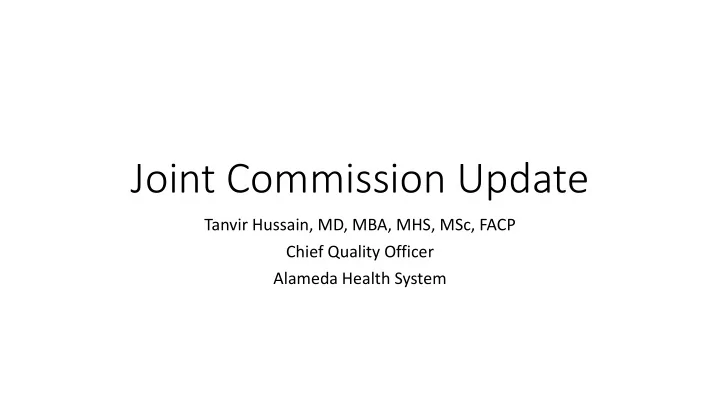

Joint Commission Update Tanvir Hussain, MD, MBA, MHS, MSc, FACP Chief Quality Officer Alameda Health System
TJC JC Quality Validation Process • We will have one combined survey – Medicare Deficiency and POC Validation surveys will occur together • Evidence Binder Checklist (~300 items) demonstrating implementation of ESCs: currently 70% have been submitted • Monitoring Dashboard (~140 items) to ensure improvement in TJC findings: 80% of metrics have some data submission • Survey Readiness Checklist (~40 items): weekly rounding on frequently cited TJC items
Positive Observations • Good engagement & skill development by Department Leaders and staff preparing ESCs, conducting rounding, determining monitoring metrics, and learning how to perform quality audits • Significant collaboration between quality and operational owners to problem solve operational issues that impede standard of care • The plan of corrections appear to be effective, driving visible improvement and local pride amongst staff
Opportunities for Im Improvement • Key areas of risk continue to be the following: • Ensuring High-Level Disinfection competencies among all staff including those on leave (Infection Control, Surgical Services) • Crash cart maintenance (Governing Body) • Suicide-Risk management including screening, assessment and documentation (Patient Rights, National Patient Safety Goals) • Environmental corrections for ligature risk (Governing Body) • Timely reassessments and renewal of orders for restraints (Patient Rights) • Preventive Maintenance of equipment (Environment of Care) • Maintenance of environment: furniture, ceiling and wall penetrations in OR and ED (Environment of Care, Infection Control)
Opportunities for Sustainability • Hardwiring ongoing competency and training for all employees in critical patient safety areas (infection control, patient rights) • Maintaining adequate resources (bandwidth, staffing) to ensure preventive maintenance of environment of care • Continuity in operations in critical areas, where there are interim leaders currently, including Peri-Operative services, Behavioral Health, Emergency Department, Sterile Process Department, Environmental Services • Leadership oversight to support consistent performance in key functional areas: taking immediate action on gaps, following established processes, executing on duties
Leapfrog Scores Nearly all of the measures (other than those measures created by Leapfrog) are tracked on our TNM dashboard and have seen significant improvement since we began tracking in QPSC beginning June 2018. Our Leapfrog score is comprised of 13 process measures and 15 outcome measures. Process Measures (13): -Seven measures can only be self-reported by Leapfrog customers. -Because we were not on EPIC yet for all of 2019, we could not report CPOE. -Five patient experience measures date back to 2018. We did not begin to see an improvement in patient experience until 2019-2020. This is an area we need to sustain momentum. Outcome measures (15): -Ten measures date back to 2016. These data are taken from CMS. -Five measures date back to 2018. Leapfrog allows paid customers to self-report HAI data. -Further, smaller facilities such as SLH and AH are impacted significantly by minor changes. -We anticipate Leapfrog will report SLH and HGH together moving forward.
Recommend
More recommend